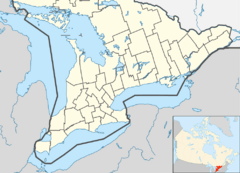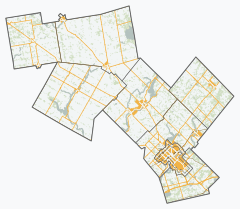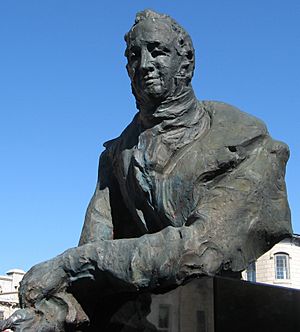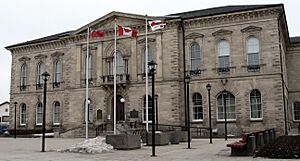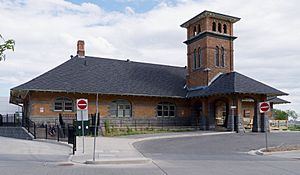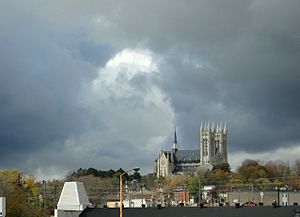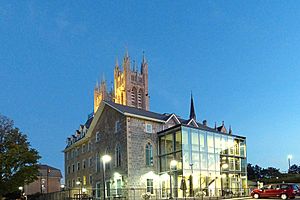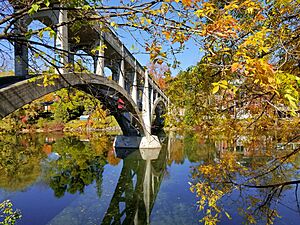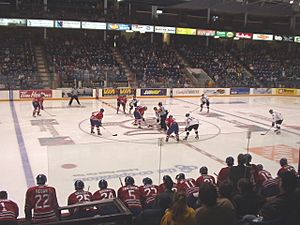Guelph facts for kids
Quick facts for kids
Guelph
|
|||||
|---|---|---|---|---|---|
| City of Guelph | |||||
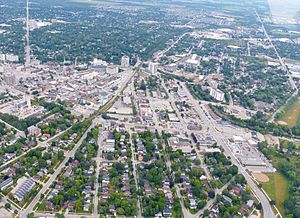
Downtown Guelph
|
|||||
|
|||||
| Nickname(s):
"The Royal City"
|
|||||
| Motto(s):
Faith, Fidelity and Progress
|
|||||
| Country | Canada | ||||
| Province | Ontario | ||||
| Founded | April 23, 1827 | ||||
| Incorporated | April 23, 1879 | ||||
| Area | |||||
| • Land | 87.22 km2 (33.68 sq mi) | ||||
| • Urban | 87.22 km2 (33.68 sq mi) | ||||
| • Metro | 593.51 km2 (229.16 sq mi) | ||||
| Elevation | 334 m (1,096 ft) | ||||
| Population
(2021)
|
|||||
| • City (single-tier) | 143,740 | ||||
| • Density | 1,644.1/km2 (4,258/sq mi) | ||||
| • Urban | 143,740 | ||||
| • Urban density | 1,644.1/km2 (4,258/sq mi) | ||||
| • Metro | 165,588 | ||||
| • Metro density | 278.3/km2 (721/sq mi) | ||||
| Demonym(s) | Guelphite | ||||
| Gross Metropolitan Product | |||||
| • Guelph CMA | CA$10.6 billion (2020) | ||||
| Time zone | UTC−05:00 (EST) | ||||
| • Summer (DST) | UTC−04:00 (EDT) | ||||
| Forward sortation area |
N1C to N1H, N1K to N1L
|
||||
| Area code(s) | 519, 226 and 548 | ||||
Guelph (pronounced GWELF) is a city in Southwestern Ontario, Canada. It's often called "The Royal City." In 2021, about 143,740 people lived there.
Guelph is located about 22 km east of Kitchener and 70 km west of Downtown Toronto. It sits where Highway 6 and Highway 7 cross. The city is the main centre for Wellington County, but it runs its own government.
The city started as a settlement in the 1820s. John Galt, who worked for the Canada Company, founded it. He made Guelph the company's main office. Guelph has often had one of Canada's lowest unemployment rates. This is partly because it has many factories, like Linamar.
Contents
History of Guelph
Early Days Before European Settlement
First Nations people lived in the Guelph area as far back as 11,000 years ago. Before European settlers arrived, the land was a "neutral" zone for different Indigenous groups. The Neutral Nation lived here in longhouses and grew corn. In 1784, the British Crown bought this land from the Mississauga people.
How Guelph Was Founded
John Galt was the first leader of the Canada Company. This British company aimed to help people settle in Upper Canada. Galt chose Guelph as the company's main base. He was a Scottish writer who designed the town to attract settlers. He wanted it to look like a European city, with wide main streets and smaller side streets. This unique layout is still seen today.
The city was officially started on April 23, 1827. This date is St. George's Day, England's patron saint day. Galt and William "Tiger" Dunlop marked the founding by cutting down a tree.
The name Guelph comes from an old German word, Welf. It was chosen to honour King George IV, who was the British king at the time. His family, the Hanoverians, were related to the Welfs. This is why Guelph is called The Royal City.
Galt built "The Priory" in 1827–1828. It was one of the first buildings and could house up to 100 people. It also served as the Canada Company office. A historical marker remembers John Galt's important role in settling this area.
By late 1827, 70 houses were built. The first police officer was hired, and the first Guelph Farmers' Market opened. James Hodgert's brewery started in 1827, and later John Sleeman opened the Silver Creek Brewery.
The first Board of Commerce began in 1827 to help the economy grow. The Canada Company also built the first grist mill for grinding grain. A sawmill was built in 1833 by Charles Julius Mickle.
In 1829, Galt was fired by the Canada Company. He returned to Britain and faced financial problems. By 1831, Guelph had about 800 residents. The town's economy struggled for a few years until wealthy immigrants arrived in 1832.
By 1846, Guelph had a stone jail and courthouse, a newspaper, five churches, and about 1,240 people. Most residents were from England and Scotland. The town had many shops, taverns, and small industries like tanneries and breweries.
Growth from 1855 to 1878
Guelph became an official town in 1855, and John Smith was its first mayor. The town grew slowly until the Grand Trunk Railway arrived in 1856. This railway connected Guelph to Toronto and Sarnia. The Great Western Railway also soon served the town. By 1858, the population had grown to about 4,500.
The first city hall, now called the Old City Hall (Guelph), was built in 1856. It was made of local Guelph stone. This building is now a National Historic Site.
Two important mills operated in Guelph during the 1800s. Allan's Mill started in 1830 on the Speed River. It was later damaged by fire in 1876. The Goldie Mill was built in 1866. Its ruins still stand today in Goldie Mill Park. The ruins were fixed up between 2019 and 2021.
The Guelph General Hospital was started in 1861. The hospital building was finished in 1875 with 12 beds.
The Basilica of Our Lady Immaculate, a large Roman Catholic church, was built between 1876 and 1888. It is a beautiful example of Gothic Revival style.
By 1869, Guelph's factories were served by both major railways. Gas was available to some homes by 1871. Electricity became common in the early 1900s. A poor house for those in need, which also housed orphans, opened in 1877. This building is now the Wellington County Museum and Archives.
Guelph as a City (After 1878)
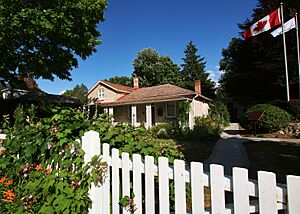
Guelph became a city in 1879. At this time, it became separate from Wellington County. The population was about 10,000. Mayor George Howard first used the term "Royal City" during the inauguration.
In the late 1800s, George Sleeman Sr. started an electric railway, the Guelph Railway Company. This railway eventually reached Toronto. It carried both people and coal.
By 1886, telephones were common in Guelph homes. In 1903, the city bought the Guelph Light & Power Company. Guelph was one of the first cities to help create Ontario Hydro, a provincial power company.
Guelph was home to North America's first cable TV system. Fredrick T. Metcalf started it in 1953. The city is also where the jockstrap was invented in 1922. Tom Ryan, who invented five-pin bowling in 1909, was from Guelph. The city's covered bridge, built in 1992, is one of only two like it in Ontario. The Yukon Gold potato was first grown at the University of Guelph in 1966.
Guelph's police force had Canada's first motorcycle patrol. Chief Ted Lamb used an army motorcycle from the First World War.
Guelph has several National Historic Sites: the Basilica of Our Lady Immaculate, McCrae House, and Old City Hall. The University of Guelph was established in 1964. It grew from three older colleges, including the Ontario Agricultural College (1874) and the Ontario Veterinary College (1862). Guelph Collegiate Vocational Institute (GCVI), started in the 1840s, is one of Ontario's oldest high schools.
In 2017, Scientology Canada moved its main office to Guelph.
A plan to redevelop Downtown Guelph started in 2018. This project aims to create new homes, shops, and offices. It will also include a new library and underground parking.
In 2019, Guelph Hydro merged with Alectra Utilities Corporation. This gave the city a share in Alectra and annual payments.
Geography
Rivers and Water Supply
Downtown Guelph is located where the Speed River and the Eramosa River meet. These two rivers flow southwest and join the Grand River (Ontario). The city has many smaller creeks and ravines, which are great for parks and trails.
Guelph is the largest Canadian city that gets almost all its drinking water from underground sources. This water comes from two main aquifers (underground water layers).
Climate and Weather
Guelph has cold winters and warm, humid summers. It gets a good amount of rain and snow. Temperatures are usually a bit cooler than areas closer to the Great Lakes.
The hottest temperature ever recorded in Guelph was 38.3°C (100.9°F) on August 6, 1918, and July 13, 1936. The coldest temperature ever recorded was -37.2°C (-35°F) on January 25, 1884.
| Climate data for University of Guelph Arboretum, 1981−2010 normals, extremes 1881−present | |||||||||||||
|---|---|---|---|---|---|---|---|---|---|---|---|---|---|
| Month | Jan | Feb | Mar | Apr | May | Jun | Jul | Aug | Sep | Oct | Nov | Dec | Year |
| Record high °C (°F) | 16.7 (62.1) |
15.5 (59.9) |
26.4 (79.5) |
29.2 (84.6) |
32.2 (90.0) |
36.2 (97.2) |
38.3 (100.9) |
38.3 (100.9) |
36.7 (98.1) |
29.4 (84.9) |
23.9 (75.0) |
19.1 (66.4) |
38.3 (100.9) |
| Mean daily maximum °C (°F) | −3 (27) |
−2.1 (28.2) |
3.4 (38.1) |
11.4 (52.5) |
18.4 (65.1) |
23.4 (74.1) |
25.9 (78.6) |
24.5 (76.1) |
19.8 (67.6) |
13.1 (55.6) |
6.2 (43.2) |
0.0 (32.0) |
11.7 (53.1) |
| Daily mean °C (°F) | −6.9 (19.6) |
−6.3 (20.7) |
−1.4 (29.5) |
6.0 (42.8) |
12.2 (54.0) |
17.1 (62.8) |
19.7 (67.5) |
18.6 (65.5) |
14.1 (57.4) |
8.1 (46.6) |
2.4 (36.3) |
−3.5 (25.7) |
6.7 (44.1) |
| Mean daily minimum °C (°F) | −10.8 (12.6) |
−10.5 (13.1) |
−6.1 (21.0) |
0.6 (33.1) |
6.0 (42.8) |
10.8 (51.4) |
13.7 (56.7) |
12.6 (54.7) |
8.4 (47.1) |
3.0 (37.4) |
−1.3 (29.7) |
−7 (19) |
1.6 (34.9) |
| Record low °C (°F) | −37.2 (−35.0) |
−32.8 (−27.0) |
−28.9 (−20.0) |
−16.7 (1.9) |
−7.8 (18.0) |
−1.1 (30.0) |
1.7 (35.1) |
−1.1 (30.0) |
−6.7 (19.9) |
−12.8 (9.0) |
−20.6 (−5.1) |
−31.1 (−24.0) |
−37.2 (−35.0) |
| Average precipitation mm (inches) | 51.9 (2.04) |
58.0 (2.28) |
66.9 (2.63) |
73.7 (2.90) |
79.7 (3.14) |
78.8 (3.10) |
95.8 (3.77) |
92.8 (3.65) |
90.4 (3.56) |
71.6 (2.82) |
91.2 (3.59) |
80.5 (3.17) |
931.3 (36.67) |
| Average rainfall mm (inches) | 17.6 (0.69) |
24.1 (0.95) |
43.8 (1.72) |
69.9 (2.75) |
79.6 (3.13) |
78.8 (3.10) |
95.8 (3.77) |
92.8 (3.65) |
90.4 (3.56) |
70.1 (2.76) |
81.2 (3.20) |
38.1 (1.50) |
782.0 (30.79) |
| Average snowfall cm (inches) | 38.6 (15.2) |
37.2 (14.6) |
26.4 (10.4) |
3.8 (1.5) |
0.07 (0.03) |
0.0 (0.0) |
0.0 (0.0) |
0.0 (0.0) |
0.0 (0.0) |
1.5 (0.6) |
9.0 (3.5) |
38.6 (15.2) |
155.1 (61.1) |
| Average precipitation days (≥ 0.2 mm) | 16.2 | 12.8 | 12.7 | 13.7 | 13.3 | 11.8 | 11.7 | 13.5 | 14.1 | 14.6 | 16.0 | 16.8 | 167.0 |
| Average rainy days (≥ 0.2 mm) | 4.0 | 3.9 | 7.9 | 12.3 | 13.3 | 11.8 | 11.7 | 13.5 | 14.1 | 14.5 | 13.4 | 6.9 | 127.4 |
| Average snowy days (≥ 0.2 cm) | 12.7 | 9.6 | 5.9 | 1.6 | 0.07 | 0.0 | 0.0 | 0.0 | 0.0 | 0.43 | 3.4 | 11.0 | 44.7 |
| Mean monthly sunshine hours | 80.4 | 96.7 | 146.3 | 172.5 | 230.7 | 256.5 | 277.9 | 236.7 | 172.2 | 140.6 | 82.1 | 55.4 | 1,947.9 |
| Percent possible sunshine | 27.8 | 32.8 | 39.7 | 42.9 | 50.6 | 55.7 | 59.5 | 54.7 | 45.8 | 41.0 | 28.1 | 19.8 | 41.5 |
| Source: Environment Canada | |||||||||||||
Guelph's Economy
Guelph has a strong and varied economy. This has helped the city have very low unemployment rates. The city isn't dependent on just one type of business. In January 2019, Guelph had the lowest unemployment rate in all of Canada.
The economy of the Guelph area has grown steadily. In 2018, Guelph's economy grew by 3.6%, which was the highest among medium-sized cities in Canada.
Main Industries in Guelph
Manufacturing is the biggest part of Guelph's economy. Making car parts is a very important part of this. Linamar is the largest company in this area, with 22 factories. They have received government money to expand and create more jobs.
Other important manufacturing areas include metal products and machinery. The city also focuses on growing industries like life science, food production (agri-food), and environmental technology.
The second largest industry in Guelph is education.
Other Economic Areas
Guelph is also a great place for agri-food and biotechnology companies. This sector has over 90 companies and employs about 6,500 people.
The city also welcomes movie and TV filming. Parts of several productions have been filmed here, like American Gods and Murdoch Mysteries.
Jobs in Guelph
In 2016, nearly 76,000 people were part of Guelph's workforce. The top job areas were:
- Sales and service
- Education, law, and government services
- Business, finance, and administration
- Trades, transport, and equipment operators
- Manufacturing and utilities
Some of the largest private employers in Guelph include:
- Linamar Corporation
- Cargill Meat Solutions
- Polycon Industries
- The Co-operators
- Guelph Manufacturing Group Inc.
- Blount Canada Ltd.
Major public sector employers include:
- Upper Grand District School Board
- University of Guelph
- City of Guelph
- Wellington Catholic District School Board
- Guelph General Hospital
- Homewood Health Centre
The University of Guelph is a big employer, with thousands of staff and student workers.
People of Guelph
| Historical populations | ||
|---|---|---|
| Year | Pop. | ±% |
| 1841 | 1,240 | — |
| 1851 | 1,860 | +50.0% |
| 1871 | 6,878 | +269.8% |
| 1881 | 9,890 | +43.8% |
| 1891 | 10,537 | +6.5% |
| 1901 | 11,496 | +9.1% |
| 1911 | 15,175 | +32.0% |
| 1921 | 18,128 | +19.5% |
| 1931 | 21,075 | +16.3% |
| 1941 | 23,074 | +9.5% |
| 1951 | 27,386 | +18.7% |
| 1961 | 39,838 | +45.5% |
| 1971 | 60,087 | +50.8% |
| 1981 | 71,207 | +18.5% |
| 1991 | 87,976 | +23.5% |
| 1996 | 95,821 | +8.9% |
| 2001 | 106,170 | +10.8% |
| 2006 | 114,943 | +8.3% |
| 2011 | 121,688 | +5.9% |
| 2016 | 131,794 | +8.3% |
| 2021 | 143,740 | +9.1% |
In 2021, Guelph had a population of 143,740 people. This was a growth of about 9% since 2016. Guelph was the third fastest-growing city in Ontario between 2011 and 2016. The number of residents can change slightly throughout the year due to students at the University of Guelph.
Backgrounds of Residents
In 2021, about 73.1% of Guelph residents were of European background. About 25.3% were from visible minorities (people who are not Indigenous or white). And 1.6% were Indigenous.
The largest visible minority groups in Guelph were South Asian, Black, Chinese, and Filipino. Many Italian Canadians live in Guelph, with many families having moved there from southern Italy in the early 1900s.
Languages Spoken
In 2021, English was the most common first language, spoken by 74.5% of the population. Other common languages included Chinese languages, Punjabi, Italian, Vietnamese, Tagalog, Spanish, and French.
Religions in Guelph
In 2021, almost half of Guelph residents (49.7%) were Christians. The largest Christian groups were Catholics and Protestants. About 38.7% of the population said they had no religion. Other religions like Islam, Hinduism, Sikhism, and Buddhism were also present.
Education in Guelph
Four different school boards operate in Guelph. The Upper Grand District School Board (UGDSB) runs public schools for all of Wellington County. The Wellington Catholic District School Board (WCDSB) manages Catholic schools. There are also French-language public and Catholic school boards.
Guelph also has many private schools. Some schools offer the International Baccalaureate (IB) Program.
High Schools
All high schools in Guelph belong to either the Upper Grand District School Board or the Wellington Catholic District School Board.
Public High Schools (Upper Grand District School Board):
- Centennial C.V.I.
- College Heights C.V.I.
- Guelph C.V.I.
- John F. Ross C.V.I.
Catholic High Schools (Wellington Catholic District School Board):
- Our Lady of Lourdes C.H.S.
- Saint James C.H.S.
- Bishop Macdonell C.H.S.
- St. John Bosco High School
A new public high school is planned to open by 2022 to help with growing student numbers.
Colleges and Universities
- University of Guelph: This university has about 25,300 students. It is known as one of Canada's top comprehensive universities. It is home to the Ontario Agricultural College and the Ontario Veterinary College.
- Conestoga College: This college has a smaller campus in Guelph. However, a major expansion is planned to serve at least 5,000 students in the coming years.
Public Library System
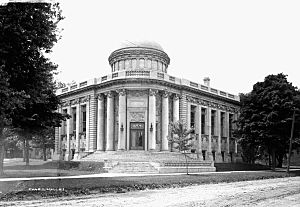
Guelph's first public library opened in 1882. It moved into a building funded by Andrew Carnegie in 1905. The current main library building opened in 1965.
The Guelph Public Library system has a main library, five branches, and a Bookmobile. The library collects historical materials about Guelph. A new main library is planned as part of the downtown redevelopment.
Museums in Guelph
Guelph Museums runs the Guelph Civic Museum. It shows the city's history with exhibits and artifacts. The Civic Museum also operates McRae House, which is the birthplace of John McCrae. He wrote the famous poem "In Flanders Fields".
City Services and Transport
Hospitals and Health Care
Guelph has one hospital, Guelph General. It is known for being one of the safest hospitals in Canada. St. Joseph's Health Centre used to be a hospital, but now it is a long-term care home.
Another important facility is Homewood Health Centre. It helps people with mental health and addiction issues. It was founded in 1883.
Getting Around Guelph
Buses
Guelph Transit provides local bus service around the city. You can also connect to other cities using GO Transit buses from the Guelph Central Station.
Trains
Guelph was the first city in Canada to own its own railway, the Guelph Junction Railway. This railway is still owned by the city.
The Guelph Central Station was built in 1911 by the Grand Trunk Railway. It is a classic example of early 20th-century train station design. It is now a heritage building. The station was renovated between 2016 and 2017.
Highways
Major highways that serve Guelph include:
- Highway 401: Connects to Toronto and London.
- Highway 7: Connects to Kitchener and Acton.
- Highway 6: Connects to Hamilton and Owen Sound. This highway is called the Hanlon Expressway within the city.
Culture and Fun in Guelph
Historic Places to See
- Downtown Guelph: Many streets have beautiful Victorian-era buildings. The Old City Hall is a National Historic Site. The Old Quebec Street Mall used to be an outdoor street in the 1800s, but it was covered in 1984 to become an indoor shopping mall.
- The Guelph Civic Museum: This museum is located near the Basilica of Our Lady Immaculate. It has many old pictures, films, and items that show Guelph's history.
- St. George's Park area: This old neighbourhood has many beautiful heritage homes and mansions.
- Exhibition Park neighbourhood: This area has Guelph's oldest park and many Victorian-style heritage homes.
- The Brooklyn and College Hill area: This is the only district in the city protected under the Ontario Heritage Act.
- St. Patrick's Ward (The Ward): This area has many old buildings and was home to many newcomers from Europe, especially Italy, after 1850.
- Allan's Mill: An old mill site.
- Heffernan Street Footbridge: This footbridge over the Speed River was built in 1913. It was restored in 1991.
- Goldie Mill ruins: These are the ruins of an old mill that was destroyed by fire in 1953. The site was reopened to the public in 2021 after being fixed up.
National Historic Sites in Guelph
- Old City Hall: A grand building built in 1856–57.
- McCrae House: The home of John McCrae, who wrote "In Flanders Fields".
- Basilica of Our Lady Immaculate: A large Roman Catholic church built from 1876 to 1888.
Outdoor Attractions
Guelph has many natural attractions along the Speed River and Eramosa River.
- Guelph Lake
- University of Guelph Arboretum
- Riverside Park
- York Road Park
- Hanlon Creek Park (Preservation Park)
- Royal City Park and Wellington Street nature sites
Festivals and Events
Guelph hosts many fun festivals throughout the year:
- Guelph Contemporary Dance Festival
- Guelph Pride and Winter Pride
- Guelph and District Multicultural Festival
- Hillside Festival (a popular music festival)
- Two Rivers Festival
- John Galt Day
- Guelph Jazz Festival
- Guelph Ribfest
- Guelph Festival of Moving Media
- Guelph Film Festival
- Vegfest Guelph
- Annual Exotic Car Show in Guelph
Arts and Entertainment Places
- The Art Gallery of Guelph
- The Bookshelf Ebar Art Space
- Ed Video Media Arts Centre
- River Run Centre
- Guelph Youth Music Centre
Media in Guelph
Online News
GuelphToday.com is a local online news source. It provides news, weather, entertainment, and sports.
Newspapers
Guelph has had newspapers since the 1840s. The Guelph Mercury was a daily newspaper for 149 years until it closed in 2016. Now, the Guelph Mercury Tribune provides local news.
Radio Stations
Guelph has two main radio stations:
- Magic 106.1 (CIMJ-FM): Plays popular music.
- CJOY, 1460: Plays oldies music.
The University of Guelph also has its own station, 93.3 CFRU-FM.
Entertainment Venues
The Sleeman Centre is a large venue for concerts, sports, and other events. It is home to the local hockey team, the Guelph Storm.
Other places for entertainment include Guelph Little Theatre, Guelph Concert Theatre, and River Run Centre. The University of Guelph also puts on theatre shows.
Music Scene
Guelph has a lively indie rock music scene. Many well-known Canadian indie bands have come from Guelph. The annual Kazoo Festival highlights these bands.
The Hillside Festival is a very popular music festival held at Guelph Lake every summer. Guelph also hosts the Guelph Jazz Festival.
The Guelph Symphony Orchestra performs classical music. There are also two yearly classical music festivals: the Kiwanis Music Festival and Guelph Musicfest.
Sports Teams
| Club | League | Sport | Venue | Established | Championships |
|---|---|---|---|---|---|
| Guelph Storm | Ontario Hockey League | Hockey | Sleeman Centre | 1991 | 4 |
| Guelph Royals | Intercounty Baseball League | Baseball | David E. Hastings Stadium at Exhibition Park | 1919 | 8 |
| Guelph Gryphons | Canadian Interuniversity Sport | University | W.F. Mitchell Centre and Alumni Stadium | 1874 | 1 |
| Guelph United F.C. | League1 Ontario | Soccer | Centennial Bowl | 2021 | 1 |
| Guelph Gryphons FC | Ontario Soccer League, Kitchener and District Soccer League, South West Region Soccer League | Soccer | Centennial Park and Guelph Lake Sports Fields | c. 1985 | 3 |
| Guelph Regals | Ontario Lacrosse Association | Lacrosse | Victoria Road Recreation Centre | 1992 | 1 |
| Guelph Jr. Gryphons | Ontario Football Conference | Football | Alumni Stadium | 1997 | 0 |
| Grand River Gargoyles | Ontario Australian Football League | Australian Football | Margaret Greene Park | 2001 | 0 |
| Royal City Roller Derby | Women's Flat Track Derby Association | Roller Derby | Arenas in Guelph (Victoria Road Rec Centre, Exhibition Park, West End Rec Centre) | 2010 | 0 |
| Speed River Track and Field Club | Athletics Canada | Athletics | Alumni Stadium | 1997 | 10 |
| Guelph Rugby F.C. | Niagara Rugby Union, Ontario Women's League, Rugby Ontario (Junior Leagues) | Rugby Union | Eastview Community Park and Exhibition Park | 2012 | 3 |
| Guelph Cricket Club | United Friendly Cricket League | Cricket | Margaret Greene Park | 2016 | 0 |
Famous People from Guelph
Sister Cities
Guelph has several sister cities around the world:
 Castelfranco Veneto, Italy
Castelfranco Veneto, Italy Riese Pio X, Italy
Riese Pio X, Italy Quetzaltenango, Guatemala
Quetzaltenango, Guatemala Cusco, Peru
Cusco, Peru
Images for kids
See also
 In Spanish: Guelph para niños
In Spanish: Guelph para niños




